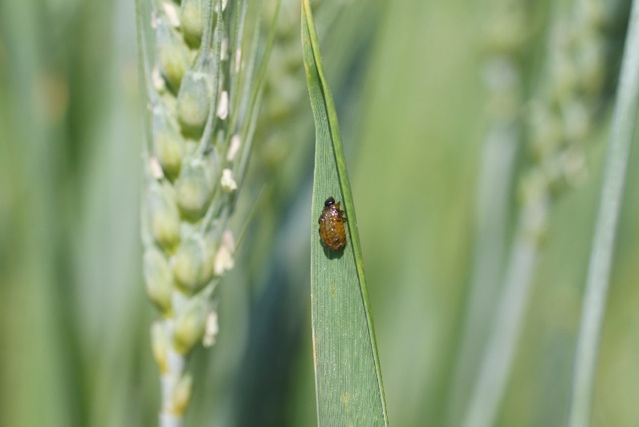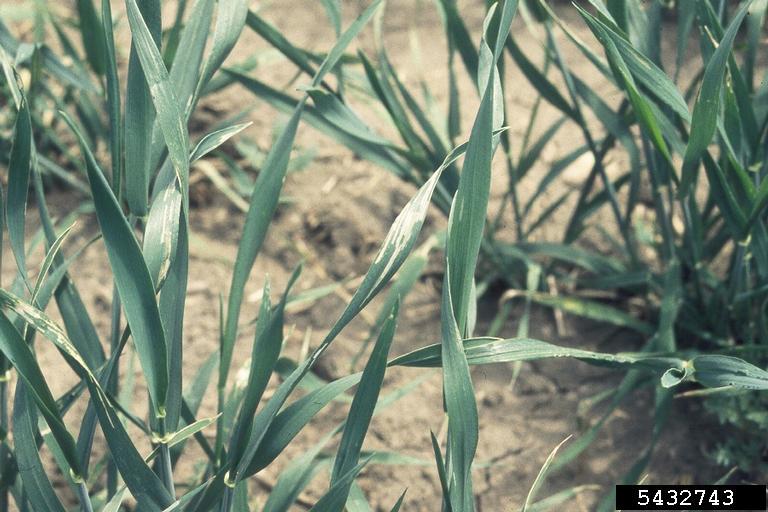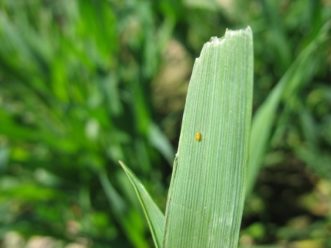The cereal leaf beetle (Oulema melanopus, CLB) can be a significant pest of small grains in North America1 and has a host range including wheat, oats, barley, rye, corn and other cultivated and non-cultivated grass species. The insect is native to Europe and was first found in the US in Michigan in 1962. The insect has since spread to much of the US, including southeastern states. The CLB has one generation per year, with overwintering occurring as an adult (figure 1) in wooded areas near small grain fields. The insect disperses to cereal crops in the spring and lays eggs singly or in groups of up to three on the upper side of leaves (figure 2). Young larvae are pale yellow with a dark brown head, and as larvae mature, they cover their bodies in mucus and fecal matter that provides protection from desiccation (figure 3). Adults are small beetles (≈ ¼ inch long) with a metallic blue head and wing covers and a red midsection (thorax) and legs.

Figure 3. Cereal leaf beetle larva covered in mucus and fecal matter to prevent desiccation. Photo credit: Francis Reay-Jones.
The insect has one generation per year, with adults emerging with increasing temperatures in early March in South Carolina. Egg-laying occurs in small grain fields and other non-cultivated grass hosts. The egg stage lasts from four to ten days, depending on temperature. Larvae develop in six to fourteen days, depending on temperature, over four instars. Pupation occurs in the soil, which can last ten to seventeen days. The second peak of adults is often seen on small grain crops in early to mid-May before dispersal to other summer hosts for feeding (including corn), followed by movement to overwintering sites.
Injury and Impact on Yield
The CLB larvae feed on leaves, leading to reduced photosynthetic potential by skeletonizing leaves. The lower epidermis is left intact, which leads to transparent strips on leaves (figure 4). Under heavy pressure, feeding can lead to whole leaves turning white, as well as reduced tillering. Adults can also feed on leaves of wheat and corn plants, but the damage is generally cosmetic, with limited to no impact on yield. The impact on yield is highly variable in wheat, with 17% reported in Virginia2 and 16% in Georgia.3 The timing of injury is an important factor affecting yield losses. Injury prior to spike emergence will lead to a greater reduction in yield than injury after spike emergence.3 Table 1 lists the growth stages in wheat according to the Feekes scale4 (figure 5).

Figure 4. Cereal leaf beetle injury to wheat. Photo credit: Bob Hammon, Colorado State University, Bugwood.org.
Table 1. The Feekes growth stages of wheat.
| Feekes Growth Stage | Description |
| 1 | Emergence |
| 2 | Tillering begins |
| 3 | Tillers formed |
| 4 | Leaf sheaths lengthen |
| 5 | Leaf sheaths strongly erected |
| 6 | First node of stem visible |
| 7 | Second node visible |
| 8 | Last leaf just visible |
| 9 | Ligule of last leaf visible |
| 10 | In ‘boot’ |
| 10.1 | Head visible |
| 10.5 | Flowering |
| 11 | Ripening |
Adapted from the Kansas State University’s Wheat Growth and Development figure.

Figure 5. Feekes scale of wheat development. Image credit: Lollato, R., (2018) Wheat Growth and Development MF3300, Kansas State University.
Management
Insecticides and Economic Thresholds
The CLB can be effectively controlled with pyrethroid insecticides. With a single generation per year on wheat, the insecticide application should be timed to when the majority of the eggs have hatched. Recent research in North Carolina and Virginia have shown that one larva or egg per four tillers is a good threshold to use.5 CLB infestations are known to be aggregated within fields,6 so sampling should be conducted at multiple sites within fields (at least four sites depending on field size). Because heavy rainfall can cause larval mortality, scouting after rainfall is recommended prior to the use of insecticides. Some growers choose to proactively control CLB by using an insecticide tank mixed with a nitrogen application at stem elongation; research has shown that such an application does not always provide an economic advantage compared to the use of economic thresholds to make management decisions.5
Biological Control
After this invasive insect was first found in the US in 1962, efforts were initially made to import and release exotic natural enemies; of five species released, four became established: Tetrastichus julis (Walker), Anaphes flavipes (Förster), Diaparsis carinifer (Thomson), and Lemophagus curtus Townes.7 A range of predators has also been shown to feed on CLB, including lady beetles, nabid bugs, and wolf spiders.8 The rate of parasitism and predation is highly variable, though parasitoids appear to be poorly established in the southeastern US.1
Cultural Practices
Studies have suggested that late planting of small grains should be avoided, as this may lead to higher CLB pressure.9, 10 Thick stands of wheat will help to reduce CLB infestations, as poor stands of wheat have been associated with higher CLB infestations. Research in North Carolina has shown that CLB does not appear to prefer thin over thick stands; rather, thin stands simply have a greater number of CLB per tiller than thick stands.11
Summary
The invasive CLB can sometimes be a serious pest of small grain crops in the US. While a range of natural enemies can be found in some parts of the US that help to reduce infestations, carefully timed insecticide applications can be effective in managing this pest.
References Cited
- Philips CR, Herbert DA, Kuhar TP, Reisig DD, Thomason WE, Malone S. Fifty years of cereal leaf beetle in the US: an update on its biology, management, and current research. Journal of Integrated Pest Management. 2011; 2(2): doi:10.1603/IPM11014.
- McPherson RM. Damage potential of cereal leaf beetles (Coleoptera: Chrysomelidae) in Virginia small grains and corn. Journal of Economic Entomology. 1983; 76:1285–1287.
- Buntin GD, Flanders KL, Slaughter RW, DeLamar ZD. Damage loss assessment and control of the cereal leaf beetle (Coleoptera: Chrysomelidae) in winter wheat. Journal of Economic Entomology. 2004; 97:374–382.
- Feekes W. De tarwe en haar milieu (In Dutch: Wheat and its environment). 1941; Verslagen Technische Tarwe Commissie, 12: 523–888.
- Reisig DD, Bacheler JS, Herbert DA, Kuhar T, Malone S, Philips C, Weisz R. Efficacy and value of prophylactic vs. integrated pest management approaches for management of cereal leaf beetle (Coleoptera: Chrysomelidae) in wheat and ramifications for adoption by growers. Journal of Economic Entomology. 2012; 105:1612–1619.
- Reay-Jones FPF. Spatial distribution of the cereal leaf beetle (Coleoptera: Chrysomelidae) in wheat. Environmental Entomology. 2010; 39:1943–1952.
- Haynes DL, Gage SH. The cereal leaf beetle in North America. Annual Review of Entomology. 1981; 26:259–287.
- Kheirodin A, Sharanowski BJ, Cárcamo HA, Costamagna AC. 2019. Consumption of cereal leaf beetle, Oulema melanopus, by generalist predators in wheat fields detected by molecular analysis. doi:10.1111/eea.12835.
- McPherson R. Seasonal abundance of cereal leaf beetles (Coleoptera: Chrysomelidae) in Virginia small grains and corn. Journal of Economic Entomology. 1983; 76:1269–1272.
- Grant JF, Patrick CR. Distribution and seasonal phenology of cereal leaf beetle (Coleoptera: Chrysomelidae) on wheat in Tennessee. Journal of Entomological Science. 1993; 28:363–369.
- Reisig DD, Bacheler JS, Heiniger R, Kuhar T, Malone S, Philips C, Tilley MS. Cereal leaf beetle (Coleoptera: Chrysomelidae) regional dispersion and relationship with wheat stand denseness. Environmental Entomology. 2012; 46:425–433.
Technical Contribution No. 6834 of the Clemson University Experiment Station. This material is based upon work supported by NIFA/USDA, under project number SC-1700532.



